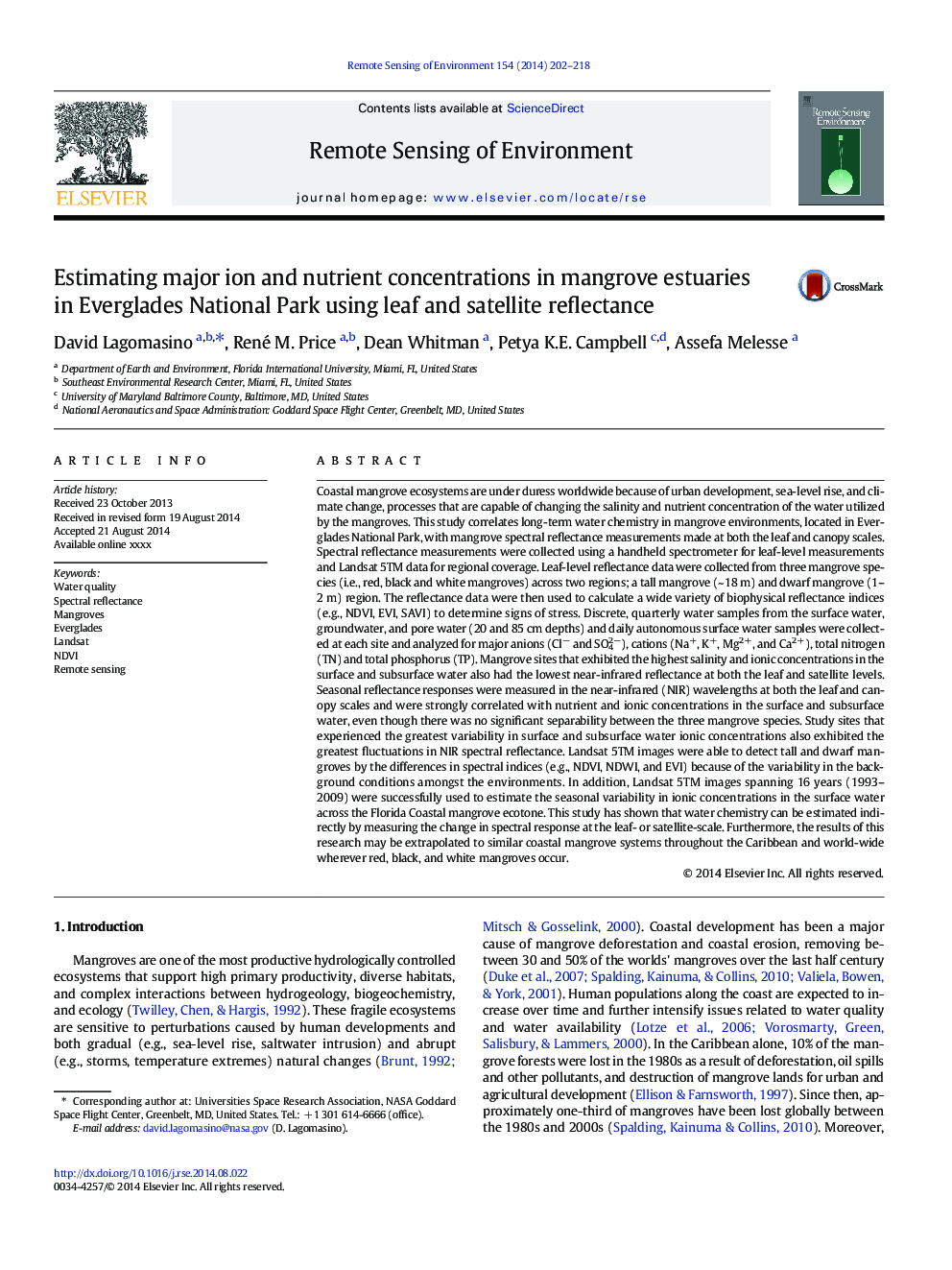| کد مقاله | کد نشریه | سال انتشار | مقاله انگلیسی | نسخه تمام متن |
|---|---|---|---|---|
| 6346433 | 1621246 | 2014 | 17 صفحه PDF | دانلود رایگان |
عنوان انگلیسی مقاله ISI
Estimating major ion and nutrient concentrations in mangrove estuaries in Everglades National Park using leaf and satellite reflectance
ترجمه فارسی عنوان
برآورد غلظت یون و مواد مغذی عمده در استوایای مانگرو در پارک ملی اورگلادل با استفاده از بازتابنده برگ و ماهواره
دانلود مقاله + سفارش ترجمه
دانلود مقاله ISI انگلیسی
رایگان برای ایرانیان
کلمات کلیدی
موضوعات مرتبط
مهندسی و علوم پایه
علوم زمین و سیارات
کامپیوتر در علوم زمین
چکیده انگلیسی
Coastal mangrove ecosystems are under duress worldwide because of urban development, sea-level rise, and climate change, processes that are capable of changing the salinity and nutrient concentration of the water utilized by the mangroves. This study correlates long-term water chemistry in mangrove environments, located in Everglades National Park, with mangrove spectral reflectance measurements made at both the leaf and canopy scales. Spectral reflectance measurements were collected using a handheld spectrometer for leaf-level measurements and Landsat 5TM data for regional coverage. Leaf-level reflectance data were collected from three mangrove species (i.e., red, black and white mangroves) across two regions; a tall mangrove (~ 18 m) and dwarf mangrove (1-2 m) region. The reflectance data were then used to calculate a wide variety of biophysical reflectance indices (e.g., NDVI, EVI, SAVI) to determine signs of stress. Discrete, quarterly water samples from the surface water, groundwater, and pore water (20 and 85 cm depths) and daily autonomous surface water samples were collected at each site and analyzed for major anions (Clâ and SO42â), cations (Na+, K+, Mg2 +, and Ca2 +), total nitrogen (TN) and total phosphorus (TP). Mangrove sites that exhibited the highest salinity and ionic concentrations in the surface and subsurface water also had the lowest near-infrared reflectance at both the leaf and satellite levels. Seasonal reflectance responses were measured in the near-infrared (NIR) wavelengths at both the leaf and canopy scales and were strongly correlated with nutrient and ionic concentrations in the surface and subsurface water, even though there was no significant separability between the three mangrove species. Study sites that experienced the greatest variability in surface and subsurface water ionic concentrations also exhibited the greatest fluctuations in NIR spectral reflectance. Landsat 5TM images were able to detect tall and dwarf mangroves by the differences in spectral indices (e.g., NDVI, NDWI, and EVI) because of the variability in the background conditions amongst the environments. In addition, Landsat 5TM images spanning 16 years (1993-2009) were successfully used to estimate the seasonal variability in ionic concentrations in the surface water across the Florida Coastal mangrove ecotone. This study has shown that water chemistry can be estimated indirectly by measuring the change in spectral response at the leaf- or satellite-scale. Furthermore, the results of this research may be extrapolated to similar coastal mangrove systems throughout the Caribbean and world-wide wherever red, black, and white mangroves occur.
ناشر
Database: Elsevier - ScienceDirect (ساینس دایرکت)
Journal: Remote Sensing of Environment - Volume 154, November 2014, Pages 202-218
Journal: Remote Sensing of Environment - Volume 154, November 2014, Pages 202-218
نویسندگان
David Lagomasino, René M. Price, Dean Whitman, Petya K.E. Campbell, Assefa Melesse,
